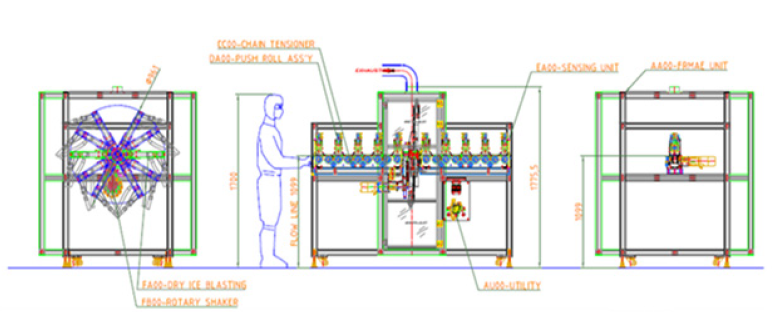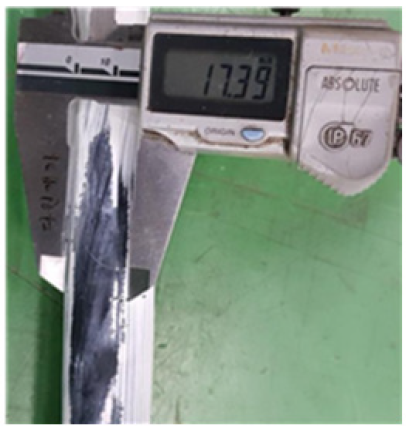- Submissions

Full Text
Aspects in Mining & Mineral Science
Study on the Reduction of Radioactive Wastes on the Wire Using Blasting Gun Process
Kyung-Min Kim1, Jae-Yong Lee1, Min-Seung Ko1, Gwang-Tae Joo2, Se-Jun Pak2, Jun-Ho Hong3 and Sung-Joon Pak3*
1Department of Nuclear Engineering, Korea
2KORASOL, Korea
2KITECH, Korea
*Corresponding author: Sung-Joon Pak, Department of Nuclear Engineering, Hanyang University, Seoul, South Korea
Submission: May 12, 2022;Published: June 17, 2022

ISSN 2578-0255Volume9 Issue3
Abstract
This study explains how to reduce the volume of radioactive wastes on the wires generated during the decommissioning process of nuclear facilities. The method involves spraying pressure treatment process to separate the aggregates from the wire; the latter of which contain the majority of the radioactive contaminants. The process acted to weaken the chemical bond between the wire and aggregate components on the wire. Optimal treatment conditions were determined to be as follows: pre-treatment for 1sec using round nozzle followed by flat nozzle horizontal to the wire for 1.5sec at room temperature. Such conditions were found to be effective at reducing the volume of the waste but could not remove the contaminants from the aggregates completely. Applying the additional process to remove the contaminants using dry ice, the clearance criteria could be attained for the aggregates separated. Therefore, the radioactive waste could be treated for clearance by the sequential treatment process, thus achieving an approximately 85% volume reduction of the radioactive waste and ultimately lowering the cost of decommissioning and waste disposal.
Keywords: Decommissioning waste; Pressure treatment; Separation efficiency; Wire
Introduction
Decommissioning is one of the most important steps in the nuclear industry and decommissioning process involves decontamination, decommissioning, waste disposal and environmental treatment, usually lasting 10-20 years [1-5]. Various types of waste generated during the decommissioning of nuclear power plants and the amount of wire waste needs to be considered. It can vary greatly depending on the type of facility, operational history, and regulatory standards [6,7]. This represents a significant technical challenge to any decommissioning project. Further, the disposal costs for the generated wastes are a significant part of the total budget for any decommissioning project [8]. Targeted treatment of the wire wastes to maximize the achievable volume reduction, for example by allowing significant volumes to be released as clearance, is one option available to reduce costs and final radioactive waste volumes destined for disposal. The IAEA define clearance as “the removal of radioactive materials or radioactive objects within authorized practices from any further regulatory control by the regulatory body” [9]. In other words, when the radionuclides are removed from the radioactive waste, through some form of treatment, and the remaining radioactivity of the waste is lower than the regulation criteria stipulate, then the treated waste could be disposed of as general industrial waste. In the case of Korea, a low and intermediate-level radioactive waste disposal facility that could dispose roughly 800,000 drums (200L per drum) of radioactive waste has been constructed [10]. The facility uses two disposal methods, underground silos, and near-surface disposal. The underground silo disposal method uses a silo built into a rock cavern within the bedrock or under the ground at 80–130m below sea level and is designated for low and intermediate-level radioactive waste [11]. The near-surface disposal, for disposing of the very low-level radioactive waste, is a method using a natural or artificial barrier at a depth of about 30 m sub-surface and is covered with soil after being filled [12]. In this study, applying the additional process to remove the contaminants using dry ice, the clearance criteria could be attained for the aggregates separated. Therefore, the radioactive waste could be treated for clearance by the sequential treatment process, thus achieving an approximately 70% volume reduction of the radioactive waste and ultimately lowering the cost of decommissioning and waste disposal.
Experiment
We simulated aged wire conditions using wire obtained from demolished buildings, which had a similar age to that of decommissioning wire waste. The purpose of the experimental program was to evaluate the separation efficiency of contaminants from the wire by air pressure treatment. To prepare the simulated surface contaminated wire, pre-cut wire was submerged in a 1L grease solution (nonradioactive) and left undisturbed until the solution dried naturally through evaporation (~1 month). In the experiment, two types of wire, non-contaminated or contaminated, were used. First, the non-contaminated wire was used to optimize the treatment conditions. Next, the previously optimized conditions were applied to the contaminated wire. In order to decontaminate all surfaces of the electric wire considering the decontamination area by the circular nozzle, the electric wire or the blasting gun must be rotated. The wire fixing method was decided by referring to the results of the evaluation of the equipment using the wire rotation method among the lab-scale mechanical decontamination equipment. In the case of the wire rotation method, it cannot change flexibly in response to wires of various thicknesses, and there is a large deviation in the degree of decontamination according to minute changes in equipment. Also, it is impossible to fix all parts of the wire with a large roller because the degree of bending of the incoming wire is severe. Therefore, it is designed in such a way that the blasting gun rotates even if the design becomes more complicated and the equipment becomes larger as shown in Figure 1.
Figure 1: Design of blast gun.

Figure 2 shows the design of decontamination equipment. The wire movement method applies the wire fixing method rather than rotating the wire. In the wire rotation method, decontamination is performed while moving and rotating the wire at the same time by rotating a disk at an angle to one side. To observe the surface morphology and analyze the concentrations of major elements in the untreated wire and separated coarse fraction, SEM (Scanning Electron Microscopy, SNE-4500M, SEC) and EDS (Energy Dispersive Spectroscopy, QUANTAX, Bruker) were used, respectively, for the non-radioactive wire sample.
Figure 2: Design of decontamination equipment.

Results and Discussion

The separation efficiency according to the spray pressure and the injection distance between the wires and blasting gun is shown in Table 1. The minimum injection pressure of the air is 3 bar, but even with more pressure, if the spraying distance is less than 3cm, the area tends to decrease. The optimum injection distance is derived from 5 to 7cm. After applying contaminants to the wire surface to qualitatively evaluate the degree of decontamination according to the form of the contaminant, the degree of decontamination due to changes in the decontamination medium is confirmed. In addition, as shown in Figure 3, scratches such as sandpaper or metal brushes on the surface of the waste wire confirmed the degree of decontamination when a source of contamination was adhered to the surface damage site of the wire. Figure 4 summarizes the results of the separation efficiency and the change of component ratio according to various treatment conditions after the process. The XRF intensity was evaluated, with the fractions dramatically increasing over 99%. The fraction of the aggregate present on the wire decreased when the wire was treated, while the wire component obtained the highest separation degree with minor change of aggregate in fraction. Figure 5 is the shape of the circular nozzle and the area where the flat nozzle is sprayed horizontally. The surface area is the widest with the circular nozzle, while the velocity is relatively slow compared to the circular nozzle in the Table 2.
Figure 3: Test sample.

Figure 4: Separation efficiency (%) and the specimens according to surface test.

Figure 5: Decontaminated area by the circular nozzle.

Table 2: Decontamination length and time according to each nozzle shape.

Conclusion
Evaluation of the air injection results are very low on all contaminant targets. There is little decontamination effect, especially for contaminants such as lakka and water-soluble paints. On the other hand, dry ice injection can make 70% of decontamination. However, in order to save the dry ice consumed when decontamination, first remove the vitreous contaminants through the air spray, and the sticky contaminants are determined by using both air and dry ice, judging that it is efficient to decontaminate with dry ice. Optimal mechanical treatment conditions were determined to be as follows: pre-treatment for 1sec using round nozzle followed by flat nozzle parallel to the wire for 1.5sec at room temperature. Such conditions were found to be effective at reducing the volume of the waste but could not remove the contaminants from the aggregates completely. Applying the additional process to remove the contaminants using dry ice, the clearance criteria could be attained for the aggregates separated. Therefore, the radioactive waste could be treated for clearance by the sequential treatment process, thus achieving an approximately 85% volume reduction of the radioactive waste and ultimately lowering the cost of decommissioning and waste disposal.
Acknowledgement
This work was supported by the Korea Institute of Energy Technology Evaluation and Planning (KETEP) and the Ministry of Trade, Industry & Energy (MOTIE) of the Republic of Korea (No. 202001510300300).
This work was supported by the Human Resources Program in Energy Technology Korea Institute of Energy Technology Evaluation and Planning (KETEP) and the Ministry of Trade, Industry & Energy (MOTIE) of the Republic of Korea (No. 20204030200100).
References
- Kim YS, Lee DJ, Kang YJ, Pak SJ (2019) Effect of solution annealing on alpha prime martensitic microstructure of cold rolled AISI316L stainless steel. Aspects Min Miner Sci 4(1).
- Kim Ys, Pak SJ (2020) Stress corrosion cracking behaviour of cold worked AISI316L stainless steel in chloride environment. Nov Res Sci 4(4).
- Menon S (1996) Decommissioning of nuclear submarines: waste minimization by recycling. In: Lesage LG, Sarkisov AA (Eds.), Nuclear Submarine Decommissioning and Related Problems, Springer, Cham, Germany, pp. 129-136.
- IAEA (2000) Organization and management for decommissioning of large nuclear facilities. International Atomic Energy Agency, IAEA Technical report series No. 399, Austria.
- Oh M, Lee K, Foster R, Lee C (2021) Feasibility study on the volume reduction of radioactive concrete wastes using thermomechanical and chemical sequential process. J Environ Chem Eng 9(4): 1-8.
- IAEA (2008) Managing low radioactivity material from the decommissioning of nuclear facilities. International Atomic Energy Agency, IAEA Technical Reports Series No. 462, Austria.
- Hopkinson KL, Bishop A, Cross MT, Harrison J, Selgas F (1998) Recycling and reuse of radioactive material in the controlled nuclear sector. EUR18041, European Commission.
- IAEA (2007) Disposal aspects of low and intermediate level decommissioning waste. International Atomic Energy Agency, IAEA-TECDOC-1572, Austria.
- IAEA (2004) Application of the concepts of exclusion, exemption and clearance. International Atomic Energy Agency, IAEA-Safety standards series No. RS-G-1.7, Austria.
- MOTIE (2015) Basic plan of the low and intermediate level radioactive waste management. Ministry of Trade, Industry and Energy of Korea, South Korea.
- Chapman N, Hooper A (2012) The disposal of radioactive wastes underground. In: Proceedings of the Geologists’ Association, 123: 46-63.
- Poskas P, Kilda R, Simonis A, Jouhara H, Poskas R (2019) Disposal of very low-level radioactive waste: lithuanian case on the approach and long-term safety aspects. Sci Total Environ 667: 464-474.
© 2022 Sung-Joon Pak. This is an open access article distributed under the terms of the Creative Commons Attribution License , which permits unrestricted use, distribution, and build upon your work non-commercially.
 a Creative Commons Attribution 4.0 International License. Based on a work at www.crimsonpublishers.com.
Best viewed in
a Creative Commons Attribution 4.0 International License. Based on a work at www.crimsonpublishers.com.
Best viewed in 







.jpg)






























 Editorial Board Registrations
Editorial Board Registrations Submit your Article
Submit your Article Refer a Friend
Refer a Friend Advertise With Us
Advertise With Us
.jpg)






.jpg)














.bmp)
.jpg)
.png)
.jpg)










.jpg)






.png)

.png)



.png)






